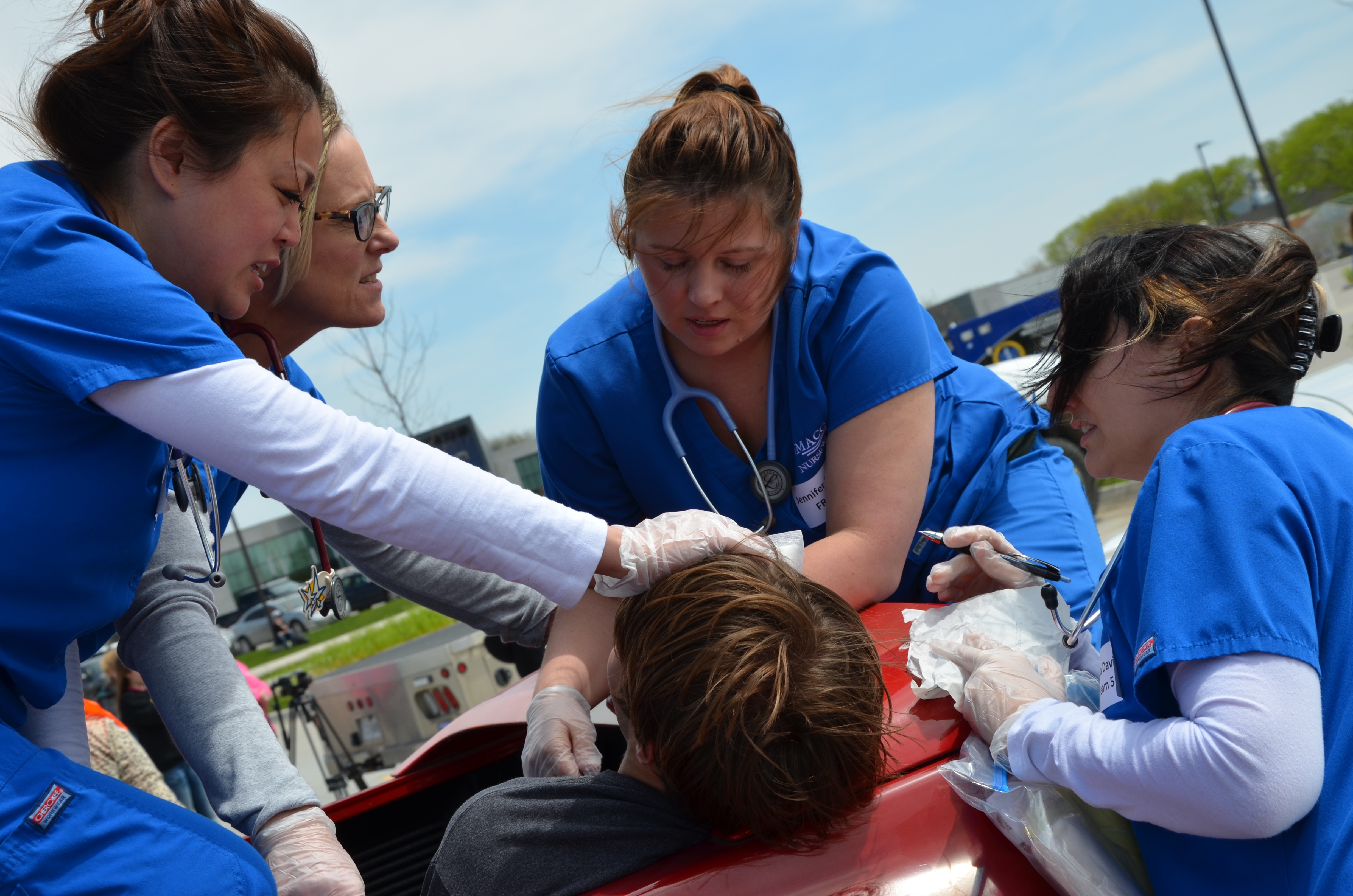Simulation in Healthcare Education
Healthcare simulation has four main purposes: Education, assessment, research, and system integration.
- Simulation education: Simulation in education provides a safe and controlled environment to teach a wide set of skills, both technical (e.g. injections, IV placement) and non-technical (soft skills such as communicating with patients).
- Simulation-based assessment: Simulation also provides a reliable educational assessment method. Assessing knowledge via exams, whether written or oral, have been a traditional way of testing for competency. However, when real tasks can be accurately simulated, having students demonstrate competency becomes the basis for effective evaluation.
- Simulated-based research: Testing medical devices or new techniques under a range of simulated conditions before they are used on real patients is one type of simulated-based research. Other types of research in this area include studying new procedures and methods in simulated conditions, and data collection via patterns in computer-based simulations. “The ultimate goal of increasing knowledge and understanding to improve training, evaluation, and design of systems is the same.”
- Systems integration of simulation: This refers to the integration of simulation-based learning into institutional healthcare training and delivery systems.2 (SSH About page)
“We simulate to observe phenomenon and solve problems. We simulate as a way to experiment complex situations while minimizing risk. In health care, we simulate to improve patient safety and practitioner skill sets.”3

History of Simulation
Medical simulation originated thousands of years ago, with models of human patients built in clay or stone to “demonstrate clinical features of diseases.” Animals were also used to educate practitioners in surgical skills.4 But the true origins of medical simulation come from a different educational source: Aviation.
Aviation embraced simulation-learning models as far back as 1929, when the first flight simulator, the “Blue Box,” was invented. Flight simulation proved that trainees exposed to high-risk conditions in safe and controlled environments could learn skills and improve on them. In addition, by standardizing the process, reproducing more and more complex simulations can allow pilots with different skill levels to achieve flight expertise.5
Read about the origins of modern simulation.
Standardized patients (SPs), live actors who simulate clinical cases in scenarios, were introduced into simulation education in the 1960s. Throughout the 1980s and ‘90s, computerized technology improved realism of manikins and led to significant improvements in team-based training. Finally, virtual reality (VR) is creating even more realistic and immersive environments for healthcare simulation education.
Adult Learning Theory
Simulation can play a central role in a student-directed learning model. Andragogy, the method and practice of teaching adult learners, encourages the adoption of student-directed learning in order to improve knowledge and increase engagement. The features of simulation that enhance adult learning include realistic scenarios, the opportunity to practice in a safe way, and constant feedback.6 Simulation itself doesn’t guarantee learning, but deployed properly, it can be the cornerstone of adult education, especially in healthcare education.

Why Use Simulation
Simulation “refers to an artificial representation of a real world process to achieve educational goals through experiential learning.”7 Though simulation has been used in different fields, including the medical field, for many years, its use in healthcare education has seen a particular increase in recent years. This leaves educators, healthcare administrators, and program coordinators faced with the choice of whether they too should take steps to integrate simulation into their curriculum. Implementing simulation into a healthcare curriculum can have dramatic impacts in skills training, faculty capacity, and patient safety.
Simulation's Impact on Faculty and Students
A dissertation by Tiffany Zyniewicz, PhDc, MSN, RN at The University of Southern Mississippi College of Nursing compared various studies conducted from 2005 to 2015 that examined the result of implementing simulation in a 1:1 or 1:2 ratio of simulation-to-clinical hours in healthcare. One 2015 study had this key finding when using a 1:2 simulation to clinical replacement ratio: “Students perceived significantly greater opportunities for collaboration with their peers in the simulated clinical setting,” but also: “students reported significantly higher satisfaction in learning in the traditional clinical setting.”8 Since student satisfaction and peer collaboration are both necessary for student success, the goal of simulation should not be to replace clinical training altogether, but to supplement and enhance education in a clinical setting.
Further, a 2014 study found:
"The replacement of 50 percent of traditional clinical with simulation at a 1:2 ratio of simulation to clinical hours resulted in a 49 percent increase in faculty capacity without negative effects to work-life quality for faculty or student simulation/clinical experiences."9
One of the major reasons that simulation entered the medical education field is because of the significant report put out by the Institute of Medicine (IOM) in 1999, To Err Is Human. This report looked at the toll medical errors take on patient safety in U.S. hospitals and recommended simulation as one solution to the problem. The report stated:
“…health care organizations and teaching institutions should participate in the development and use of simulation for training novice practitioners, problem solving, and crisis management, especially when new and potentially hazardous procedures and equipment are introduced.”10
Simulation's Impact on Skills Training and Patient Safety
Using simulation to educate students on specific and complicated tasks in a risk-free environment may seem intuitive to some, but there are those who are slow to adapt and who question its necessity and impact on real-world patients. While the IOM report encouraged the use of simulation for novice practitioners, simulation programs aimed at experienced practitioners can have surprising results. A 2017 study conducted in the United Kingdom, which implemented weekly in-situ simulation team training for a pediatric Medical Emergency Team, concluded, “sustained improvement in the hospital response to critically deteriorating in-patients, significantly improved patient outcomes and substantial savings.”11
Simulation can also have positive impacts on a student’s clinical education. A study in 2011 found that, “after four weeks of clinical, students that had experienced simulation scored significantly higher on overall clinical performance than their peers who had not experienced simulation.”12
Read more about the economics and customization of simulation.

How to Use Simulation Effectively
Simulation is a favored teaching methodology in healthcare simulation. It allows students to build hands-on experience in a risk-free, psychologically safe environment. For more on what simulation is and why it’s used, see our previous posts on the subject.
For all its benefits, adopting simulation can be difficult. Consider the following best practices when adopting or refining simulation for your program.
Incorporating Simulation
Prior to implementing a simulation program, ask yourself the following questions:
- What are our learning outcomes? Simulation is a methodology, not a goal. Use it to support your students’ learning objectives. Be clear with your students and staff on their learning objectives, measure key metrics, and evaluate success.
- Is simulation right for my program? Simulation isn’t right for every institution or program. Consider the merits of simulation versus alternative teaching methods like lectures, problem-based learning, clinical experience, peer-assisted learning, and multimedia learning.
- Where should we integrate simulation? Integrating simulation into a four-year curriculum from nothing is an ambitious undertaking. If your institution is adopting simulation for the first time, consider implementing in a single module or course. Faculties with some simulation experience can expand incrementally.
- Who is the simulation team? An ideal simulation team includes one or more instructors, content experts, and simulation technicians. Smaller programs may have fewer faculty members available. Before an instructor can adopt simulation, they must buy-in to its usefulness and be trained on best practices.
Once your plan is defined, implement and monitor progress based on your learning outcomes. Continue to test new ways to run scenarios to find the most effective strategy.
Designing a Scenario
Scenarios should be designed based on what resources your facility has available. For example, if you’re teaching students to identify heart and lung sounds with a stethoscope, does your program have access to simulated participants? If not, do you have a manikin that accurately depicts those sounds?
Format the scenario based on your desired learning outcomes. Can the skill be safely and consistently learning through clinical immersion? Are students able to practice independently using a computer program?
Well-designed scenarios share common elements. Consider the following during the design stage:
- Context: The scenario must mimic the complexity of a clinical situation. Script a comprehensive backstory for the patient’s file or practitioner inquiry. You should also prepare touchpoints to advance the scenario and react to participant actions.
- Progress: Scenarios must be completed in a reasonable amount of time. Develop time frames to facilitate progression.
- Standardization: Some elements will change between scenarios, but it’s the instructor’s responsibility to maintain a similar experience among students. For example, dialog should remain consistent for all participants.
- Metrics: Review key actions for your given scenario. Assign values to participant actions for a consistent comparison of student performance. Establish measures to verify the effectiveness of the simulation.
Sources:
INACSL Standards Committee, “INACSL Standards of Best Practice: SimulationSM Simulation Design,” Clinical Simulation in Nursing, December 2016. https://www.nursingsimulation.org/article/S1876-1399(16)30126-8/fulltext
Matola, I., et al. “Simulation in healthcare education: A best evidence practical guide.” AMEE Guide No. 82, Medical Teacher. https://www.tandfonline.com/doi/full/10.3109/0142159X.2013.818632
Learn to design and run a scenario.

The State of Simulation Education
Pocket Nurse founder and CEO Anthony Battaglia, RN, MSN, BSN, has been involved with nursing education and healthcare simulation since 1992. Having nurse educators on the team to familiarize Sales, Customer Service, and Marketing department employees has always been important to him. Current corporate nurse educators are Fabien Pampaloni, MSN, RN and Beth Telesz MSN, RN.
Recently, Dawn Mangine, content manager, sat down for a conversation with Anthony, Fabien, and Beth ahead of Healthcare Simulation Week, which is sponsored and promoted every year by Society for Simulation in Healthcare (SSH). Here are their thoughts about the current state and future of simulation in healthcare education. (Hint: It’s really good.)
What recent technologies are revolutionizing the world of simulation?
The biggest thing now is virtual reality. VR has really taken hold, not only stand-alone virtual reality systems, but also manikin simulators, which incorporate VR into the manikins.
Technology in general is also getting better and being used more. Video and audio technology is improving in simulation centers. Instructors have a variety of modalities they can employ.
Where do you see simulation headed in the near future?
Simulation is in its pre-adolescence stage, and there is a lot of potential for growth and opportunity. Clinical space is limited, plus simulation can more directly address specialties such as pediatrics and OB. In addition, we are seeing the growth of continuing education. Anthony says, “The majority of our customers are colleges and universities, but don’t forget simulation for continuing education is also growing. In the hospital sector, they are building simulation centers for the education of their own staff.”
Students are missing fewer opportunities because of the access to simulation in education. “Simulation is the way we are educating people when there is a real-life experience missing in the clinical setting,” adds Beth.
Are you concerned or excited by the increasing rate institutions are adopting simulation?
We are excited because if simulation weren’t being adopted, if we didn’t have the nursing studies that support the integration of simulation into education, we’d be going backward. It’s exciting to be in this industry and it’s exciting to see the growth that is still possible.
Patients are going to recognize and expect safer healthcare because of the simulation education that is happening with students now.
"Simulation is fiction. Your decisions are real."
Although the field is exciting, one concern to acknowledge is expanding legislation and regulations. “I wonder as simulation is adopted, how organizations will standardize education,” says Fabien. “Will everybody follow standards of good practice?”
Anthony believes states will regulate simulation education, just as how many states have guidelines around hours of simulation versus hours of clinical education. In addition, professional organizations like SSH and INACSL have created standards, definitions, and terms that educational organizations are going to be eager to adopt.
What do you believe triggered the somewhat urgent need for simulation we have witnessed in recent years?
Again, the lack of clinical space, the need for patient safety, and the need for better healthcare practices have spurred the growth in simulation. Especially in areas like pediatrics and obstetrics, where clinical opportunities are not easily accessible. As the needs in specialties grow, simulation is able to fill those spots.
Another thing we have seen cited often as simulation in healthcare education has grown and been studied is the Institutes of Medicine report To Err is Human. While simulation has been used for a long time in anesthesiology, and in CPR and skills labs, the movement of simulation being a basic expectation kicked off with that report, which came out in 1999.
Competition between healthcare education programs is a factor too. “If I were a nursing student today,” Beth says, “I’d be looking for the college that had the best simulation center.” Accrediting organizations are having an impact as well.
Anthony adds, “As we say, ‘Simulation is fiction; your decisions are real.’”
Resources
1. “About Simulation” from Society for Simulation in Healthcare (SSIH) About page https://www.ssih.org/About-SSH/About-Simulation
2. Ibid
3. Editorial, “The Value of Simulation in Health Care: The Obvious, the Tangential, and the Obscure,” Clinical Simulation in Nursing, 2017. https://www.nursingsimulation.org/article/S1876-1399(17)30357-2/fulltext
4. Jones, F., Passos-Neto, C.E., Braghiroli, O., “Simulation in Medical Education: Brief history and methodology,” Practices and Practice of Clinical Research, Jul-Aug. 2015. https://pdfs.semanticscholar.org/4bb5/413c9ce13c27a1b5cc2e186b9b157997ba28.pdf
5. Ibid
6. https://www.ncbi.nlm.nih.gov/pmc/articles/PMC3195067/ - “Simulation-based medical teaching and learning”
7. https://sigma.nursingrepository.org/bitstream/handle/10755/620250/16_Zyniewicz_T_p81393_1.pdf?sequence=1&isAllowed=y - The university of southern Mississippi college of nursing – “Simulation as Replacement for Clinical in Undergraduate Nursing Education: Ratios of Simulation to Clinical Replacement Time”
8. Ibid
9. Ibid
10. Kohn LT, Corrigan JM, Donaldson MS, editors. To err is human: building a safer health system A report of the Committee on Quality of Health Care in America, Institute of Medicine. Washington, DC: National Academy Press; 2000. [Reference list]
11. https://www.ncbi.nlm.nih.gov/pubmed/28359769 – “Regular in-situ simulation training of paediatric Medical Emergency Team leads to sustained improvements in hospital response to deteriorating patients, improved outcomes in intensive care and financial savings.”
12. https://onlinelibrary.wiley.com/doi/pdf/10.1111/acem.13327 - “Communicating Value in Simulation: Cost-Benefit Analysis and Return on Investment”




